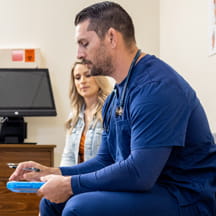There has been a common perception that doctors, nurses and others in health care never let their jobs get to them. No matter how challenging the day, they just put it behind them despite how they may be feeling on the inside. But that has never been true, and the pandemic shone a light on the reality. A new program at Children’s Hospital Los Angeles (CHLA) aims to provide emotional support to staff members suffering from job-related stress.
Through the Healing Response Team (HeaRT), peer volunteers are trained to give in-the-moment care and support to hospital employees who experience a stress injury or become a second victim, no matter their role at the hospital. “HeaRT is rooted in the understanding that we are all bonded to CHLA’s mission to create hope and build healthier futures,” says Leah Rybarczyk, LCSW, co-creator and program coordinator of HeaRT. “We recognize that our patients and families deserve our best, and it’s hard to be at our best when we’re not receiving care and support for the everyday stresses of our work.”
Although CHLA isn’t the only hospital with a peer support program, Rybarczyk points out that most other programs begin with one floor or unit, usually the Emergency Department or an intensive care unit, and grow from there. “At CHLA, we understand that no one has a more stressful job than anyone else. We have different roles, but everyone deserves support in the exact same way. So from the beginning, we said, ‘We’re going to launch this program everywhere, all together.’”
Our patients and families deserve our best, and it’s hard to be at our best when we’re not receiving care and support for the everyday stresses of our work.
Stress injuries and second victims
A stress injury is a persistent psychological difficulty caused by a traumatic experience or prolonged periods of high stress or fatigue. Doctors, nurses, social workers and others in health care encounter this type of injury in their daily work. Stress injuries can dramatically alter their ability to cope and can affect the quality of their work.
A similar injury can occur when providers experience what is known as the second victim phenomenon. A second victim can be anyone involved in a stressful event whose emotional and psychological well-being is negatively affected by the experience. Second victims may feel personally responsible for a stressful event, second-guess their clinical skills or feel as though they have failed their patients.
“We know through experience and literature that there is a wide range of events that can create a second victim,” says Rybarczyk. “It could be the doctor performing CPR, the environmental services worker cleaning up after a code blue event, or the team member receiving a call about a critical patient transferring to the hospital.”
Everyday risks
The HeaRT training curriculum is largely based on the Stress First Aid model of care, which originated in the United States military and was translated for the health care setting by the National Center for Post-Traumatic Stress Disorder and the Schwartz Center for Compassionate Healthcare. “The literature on Stress First Aid identifies the top 10 events for which you should always check on the people involved,” says Rybarczyk. “One of them is ‘anything involving children.’ At CHLA, that’s all we do! Our team members experience traumas involving children every day.”
'Every trigger situation and every individual involved is worthy of a check-in by a peer supporter'
At CHLA, certain events are considered “automatic triggers” to which a peer supporter is immediately dispatched: patient deaths, code blue events (emergency/CPR), traumatic injuries, and child abuse cases, among others. But any team member who experiences a stressful situation can request peer support. “We recognize that every trigger situation and every individual involved is worthy of a check-in by a peer supporter,” says Rybarczyk. “Because we just don’t know when or how something’s going to affect us.”
Becoming a HeaRT supporter
HeaRT peer supporters attend a four-hour workshop that focuses on elements of Stress First Aid, teachings from a peer support program at Nationwide Children’s Hospital, and what Rybarczyk calls CHLA’s “home-grown” trainings. A brief check-in is usually enough to alleviate a team member’s emotional response to an event. Peer supporters aren’t there to fix everything, but to make space for emotions—to sit, listen, and process.
“We know that our team members are already giving support to one another,” says Rybarczyk. “It’s innate to being a caretaker, especially in a children’s hospital. But we have found that they don’t always know what to say, how to say it, and maybe most importantly, when to hand it off for additional support.” In those cases, HeaRT can call on one of the other peer support services at CHLA: the chaplains who lead “Tea for the Soul,” the Employee Assistance Program, social workers and psychologists. All of these specialists have skills that are complementary to HeaRT and help ensure team members get the support they need.



